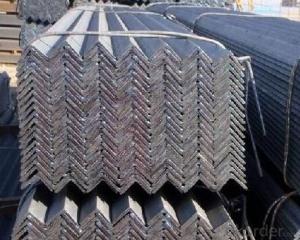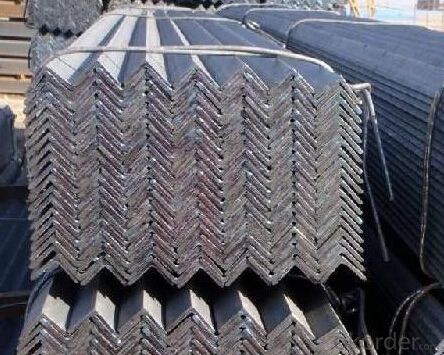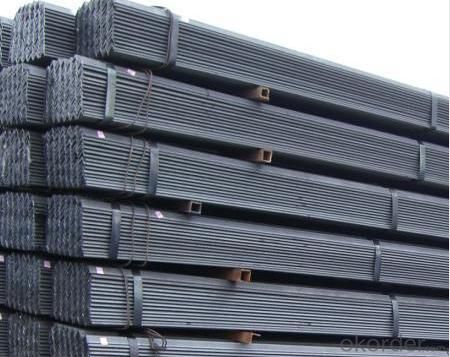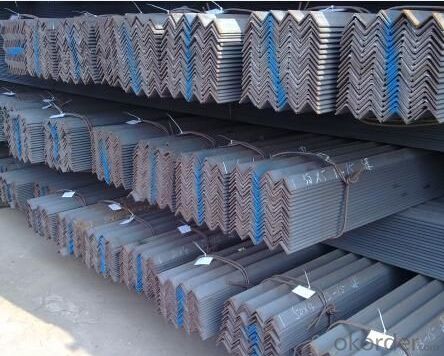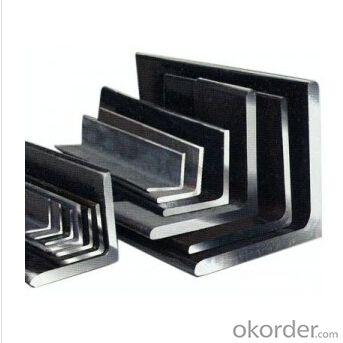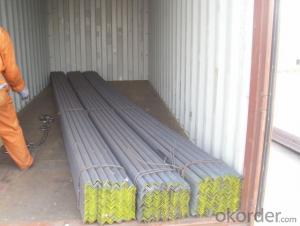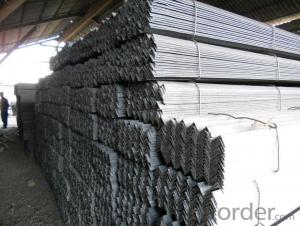Stainless Equal Angle Steel with High Quantity of Q235B
- Loading Port:
- Tianjin
- Payment Terms:
- TT OR LC
- Min Order Qty:
- 50 m.t.
- Supply Capability:
- 10000 m.t./month
OKorder Service Pledge
OKorder Financial Service
You Might Also Like
Stainless Equal Angle Steel with High Quantity of Q235B
1. Structure of Stainless Equal Angle Steel with High Quantity of Q235B
Angle steel has equal angle, unequal angle.
Standards: GB,ASTM,BS,AISI,DIN,JIS Material:
Material: GB Q235B, Q345B or Equivalent; ASTM A36; EN 10025, S235JR, S355JR; JIS G3192, SS400; SS540.
Sizes:
Sizes: 25mm-250mm | ||
a*t | ||
25*2.5-4.0 | 70*6.0-9.0 | 130*9.0-15 |
30*2.5-6.6 | 75*6.0-9.0 | 140*10-14 |
36*3.0-5.0 | 80*5.0-10 | 150*10-20 |
38*2.3-6.0 | 90*7.0-10 | 160*10-16 |
40*3.0-5.0 | 100*6.0-12 | 175*12-15 |
45*4.0-6.0 | 110*8.0-10 | 180*12-18 |
50*4.0-6.0 | 120*6.0-15 | 200*14-25 |
60*4.0-8.0 | 125*8.0-14 | 250*25 |
Material details:
Alloy No | Grade | Element (%) | |||||
C | Mn | S | P | Si | |||
|
|
|
|
|
|
| |
Q235 | B | 0.12—0.20 | 0.3—0.7 | ≤0.045 | ≤0.045 | ≤0.3 | |
|
|
|
|
|
|
| |
Alloy No | Grade | Yielding strength point( Mpa) | |||||
Thickness (mm) | |||||||
≤16 | >16--40 | >40--60 | >60--100 | ||||
≥ | |||||||
|
|
|
|
|
| ||
Q235 | B | 235 | 225 | 215 | 205 | ||
Alloy No | Grade | Tensile strength (Mpa) | Elongation after fracture (%) | ||||
Thickness (mm) | |||||||
| ≤16 | >16--40 | >40--60 | >60--100 | |||
≥ | |||||||
|
|
|
|
|
|
| |
Q235 | B | 375--500 | 26 | 25 | 24 | 23 | |
2. Main Features of angle steel
Broad-spectrum
High quantity
High strength
3.Usage & Applications of GB Q235 Angle Steel
Trusses
Transmission towers;
Telecommunication towers;
Bracing for general structures;
Stiffeners in structural use.
4.Packaging & Delivery of GB Q235 Angle Steel
Transportation: the goods are delivered by truck from mill to loading port, the maximum quantity can be loaded is around 40MTs by each truck. If the order quantity cannot reach the full truck loaded, the transportation cost per ton will be little higher than full load.
With bundles and load in 20 feet/40 feet container, or by bulk cargo, also we could do as customer's request.
Marks:
Color mark: There will be color marking on both end of the bundle for the cargo delivered by bulk vessel. That makes it easily to distinguish at the destination port.
Tag mark: There will be tag mark tied up on the bundles. The information usually including supplier logo and name, product name, made in China, shipping marks and other information request by the customer.
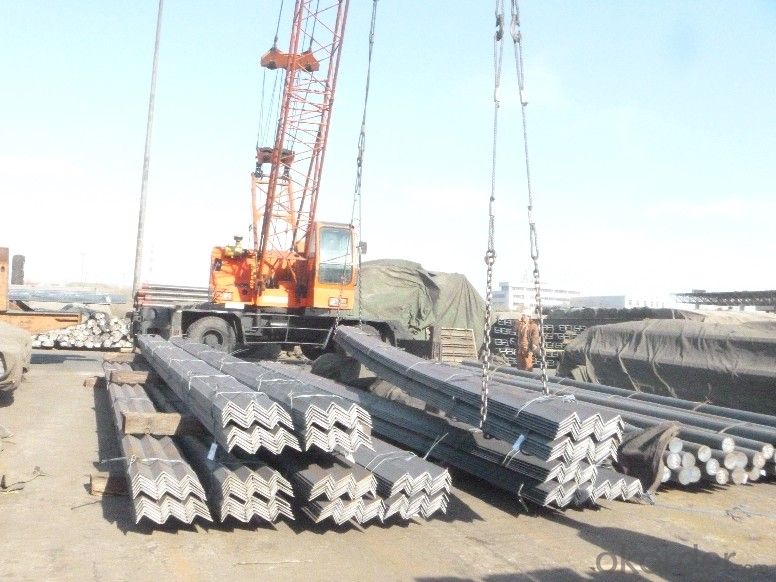
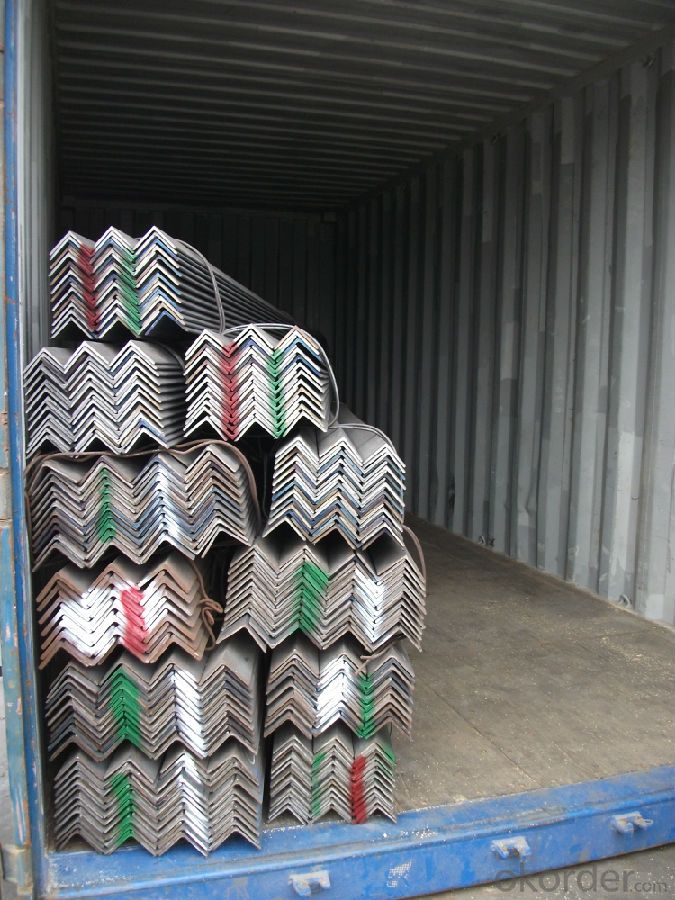
5.FAQ
We have organized several common questions for our clients,may help you sincerely:
①How about your company?
A world class manufacturer & supplier of castings forging in carbon steel and alloy steel,is one of the large-scale professional investment casting production bases in China,consisting of both casting foundry forging and machining factory. Annually more than 8000 tons Precision casting and forging parts are exported to markets in Europe,America and Japan. OEM casting and forging service available according to customer’s requirements.
②How to guarantee the quality of the products?
We have established the international advanced quality management system,every link from raw material to final product we have strict quality test;We resolutely put an end to unqualified products flowing into the market. At the same time, we will provide necessary follow-up service assurance.
③How long can we receive the product after purchase?
In the purchase of product within three working days, We will arrange the factory delivery as soon as possible. The pecific time of receiving is related to the state and position of customers.Commonly 7 to 10 working days can be served.
- Q: Can steel angles be used in sign support structures?
- Absolutely! Sign support structures can definitely utilize steel angles. These angles are widely employed in construction owing to their remarkable robustness and endurance. They offer exceptional support and stability, rendering them ideal for various applications, including sign support structures. By welding or bolting steel angles together, a strong framework can be effortlessly created for sign mounting. Furthermore, their exceptional load-bearing capacity is crucial in guaranteeing the sign's security and stability, particularly during unfavorable weather conditions. Moreover, steel angles can be tailored to meet specific design specifications, making them a versatile option for sign support structures.
- Q: How do you prevent steel angles from warping?
- To prevent the warping of steel angles, there are several measures that can be taken: 1. Store the steel angles in a dry environment and avoid moisture exposure. This will prevent rust and warping. Use pallets or racks to store them horizontally, minimizing bending stress. 2. Employ controlled cooling techniques during fabrication. Rapid temperature changes can induce warping, so it is important to cool gradually. Air cooling or controlled cooling baths can help avoid thermal stresses and minimize warping. 3. Minimize heat input during welding. Excessive heat can cause localized thermal expansion and contraction, leading to warping. Utilize proper welding techniques such as shorter welding times, smaller weld beads, and intermittent welding to control the temperature gradient and minimize heat input. 4. Consider preheating and post-welding stress relief for thicker or high-strength steel angles. Preheating before welding can reduce the risk of warping, and post-welding stress relief heat treatments can relieve any residual stresses and prevent warping. 5. Handle and transport the steel angles properly. Adequately support and secure them during transit to avoid bending or flexing. Avoid dropping or mishandling, as this can introduce structural deformations that lead to warping. By implementing these preventive measures, the risk of steel angles warping can be minimized, ensuring their structural integrity for various applications.
- Q: How do steel angles compare to wooden beams?
- Steel angles and wooden beams have different properties and strengths, making them suitable for different applications. Steel angles, being made of steel, are incredibly strong and durable. They have high tensile strength and are resistant to bending and warping under heavy loads. This makes them an excellent choice for structural support in buildings, bridges, and other types of construction projects. Steel angles are also non-combustible, which is an advantage in terms of fire safety. On the other hand, wooden beams offer certain advantages as well. Wood is a natural material that is readily available and renewable, making it a more environmentally friendly option compared to steel. Wooden beams also have a certain aesthetic appeal, especially in traditional or rustic designs. They can be easily customized and shaped, allowing for more creative and intricate designs. However, wooden beams have limitations in terms of strength and durability. They are not as strong as steel angles and can be susceptible to bending, warping, and rotting over time. Wood is also combustible, which can be a safety concern. In summary, steel angles and wooden beams each have their own strengths and weaknesses. Steel angles are ideal for projects requiring high strength and durability, while wooden beams offer a more natural and aesthetic appeal. The choice between the two ultimately depends on the specific requirements of the project, budget considerations, and personal preferences.
- Q: How do you calculate the effective length of a steel angle?
- When calculating the effective length of a steel angle, there are two main factors to consider: the actual length of the angle and the stability of its supported members. To begin, you must determine the actual length of the steel angle. This can be done by physically measuring it or referring to the manufacturer's specifications. It is crucial to have the precise length value for the calculation. Next, evaluate the stability of the angle's supported members. The effective length of the angle is influenced by the specific conditions in which it is being used and supported. There are three primary support conditions to take into account: pinned-pinned, fixed-fixed, and fixed-pinned. In the case of a pinned-pinned support condition, the effective length is equal to the actual length of the angle. This condition assumes that both ends of the angle can freely rotate, allowing the full length to effectively resist applied loads. For a fixed-fixed support condition, the effective length is typically considered as 0.7 times the actual length. This condition assumes that both ends of the angle are rigidly connected, resulting in a reduced effective length due to the increased stiffness of the entire system. In a fixed-pinned support condition, the effective length is usually 0.85 times the actual length. In this scenario, one end of the angle is fixed while the other end can rotate freely, leading to a decreased effective length compared to the actual length. Accurately determining the support conditions of the steel angle is essential for correctly calculating its effective length. In addition, a comprehensive analysis of the angle's behavior should consider other factors such as its material properties, cross-section, and loading conditions.
- Q: How do you store steel angles?
- Steel angles have various storage options depending on space availability and quantity. Here are a few commonly used techniques: 1. Vertical Storage: To store steel angles vertically, they can be leaned against a wall or placed on a storage rack. This method works well for smaller quantities, allowing easy access to each angle. It is crucial to ensure stability and secure positioning to prevent accidents. 2. Horizontal Storage: For larger quantities, steel angles can be stored horizontally. This can be achieved by stacking them on a pallet or using a compartmentalized storage rack. When stacking, it is important to evenly distribute the weight and use spacers between angles to prevent deformation. 3. Bundled Storage: When dealing with a large number of steel angles, bundling them together can be a convenient storage method. This involves tying the angles with steel strapping or using banding equipment. Bundling helps maintain organization and prevents shifting or falling during storage or transportation. Regardless of the chosen storage method, the following points should be considered: - Provide a clean and dry storage area to prevent rust or corrosion. - Ensure proper ventilation to avoid moisture buildup. - Keep angles away from direct sunlight and extreme temperature changes. - Regularly inspect for damage or corrosion. - Use appropriate lifting equipment and follow safety guidelines when moving or stacking steel angles.
- Q: How do steel angles contribute to the overall earthquake resistance of a structure?
- Several ways contribute to the overall earthquake resistance of a structure by steel angles. Firstly, steel angles are commonly utilized as reinforcement elements in the construction industry. When installed and anchored properly, they can enhance the strength and stability of a structure, making it more resistant to the lateral forces generated during an earthquake. Moreover, steel angles are often employed in the creation of moment-resisting frames. These frames, composed of interconnected steel angles, are designed to absorb and distribute seismic energy throughout the structure. By distributing the seismic load, steel angles help prevent concentrated stress points and potential structural failures. Furthermore, steel angles can be strategically positioned at key locations, such as corners, junctions, and openings, to enhance the overall stiffness and rigidity of the structure. This increased stiffness assists in reducing the building's response to seismic vibrations and prevents excessive deformations that may lead to structural damage. Additionally, steel angles enable the creation of diagonal bracing systems, which are crucial for mitigating the effects of seismic forces. These systems consist of interconnected steel angles placed diagonally within the structure, forming a network that improves the building's ability to withstand lateral loads. Diagonal bracing effectively dissipates earthquake energy and redirects it away from critical components, thus enhancing the overall earthquake resistance of the structure. In conclusion, steel angles play a vital role in enhancing the earthquake resistance of a structure. They provide reinforcement, create moment-resisting frames, increase stiffness, and allow for the installation of diagonal bracing systems, all of which contribute to the structural integrity and resilience of a building during seismic events.
- Q: What is the maximum deflection allowed for steel angles?
- There are various factors that determine the maximum deflection allowed for steel angles, such as the specific grade of steel, the angle's length, and the applied load. In the field of structural engineering, deflection limits are established in order to ensure the safety and performance of structures. Typically, the deflection limit for steel angles is expressed as a fraction of the span length, denoted as L/240 or L/360, where L represents the unsupported length of the angle. For instance, if the unsupported length of a steel angle measures 240 inches, the allowable maximum deflection would be either 1 inch (240/240) or 0.67 inches (240/360). Nevertheless, it is crucial to acknowledge that these deflection limits may vary depending on the specific design codes and standards employed in a given project. For more precise and specific information regarding the maximum deflection permitted for steel angles in a particular application, it is advisable to consult the relevant code or seek guidance from a structural engineer.
- Q: Can steel angles be used for equipment racks or shelving?
- Equipment racks or shelving can indeed utilize steel angles. The robustness, endurance, and adaptability of steel angles make them widely employed in construction and fabrication. These angles offer structural reinforcement and steadiness, rendering them perfect for crafting resilient equipment racks or shelving units. By welding or bolting steel angles together, a sturdy framework can be created to hold an assortment of items, including weighty machinery, tools, or storage containers. Moreover, the flexible design of steel angles permits effortless customization and adjustment of shelf heights, making them suitable for accommodating diverse sizes and types of objects. In conclusion, steel angles are a dependable choice for constructing equipment racks or shelving systems that necessitate strength, stability, and longevity.
- Q: Can steel angles be used for reinforcement bars?
- Steel angles cannot be used as reinforcement bars. Despite being made of steel, they possess different structural properties and serve different purposes. Reinforcement bars, or rebar, are specially designed to enhance the tensile strength and reinforcement of concrete structures. They have a ribbed or deformed surface that facilitates better bonding with the concrete. Conversely, steel angles are L-shaped structural components primarily employed for support and stability in construction endeavors. They are unsuitable for providing the necessary tensile strength and bonding required for concrete reinforcement. Hence, it is imperative to use the appropriate materials for their intended purposes to ensure the construction project's structural integrity and safety.
- Q: What are the different types of connections used for steel angles in residential applications?
- In residential applications, steel angles can be connected using various types of connections. Some commonly used ones are: 1. Welded connections: The angle is welded to nearby structural members like beams or columns. Welded connections offer great strength and rigidity, making them ideal for residential purposes. 2. Bolted connections: Bolts and nuts are used to secure the steel angle to adjacent members. This type of connection is suitable when the angle needs to be easily removable or adjustable. Bolted connections are less rigid than welded ones but still provide sufficient strength for residential use. 3. Clip connections: Clips or brackets are attached to the angle, which is then fastened to wood or non-steel materials using screws or nails. Clip connections are commonly used in residential framing. 4. Gusset plate connections: When two steel angles need to be joined, a flat steel plate known as a gusset plate is welded or bolted to the angles for added support and rigidity. This connection type is often found in residential roof trusses and other structural applications. 5. Cleat connections: A steel plate called a cleat is either bolted or welded to the steel angle and the adjacent member. Cleat connections are frequently used when the angle needs to be attached to a horizontal member like a floor or roof joist. These examples showcase the different connection types employed for steel angles in residential applications. The choice of connection will depend on factors such as structural requirements, ease of installation, and the materials being connected.
Send your message to us
Stainless Equal Angle Steel with High Quantity of Q235B
- Loading Port:
- Tianjin
- Payment Terms:
- TT OR LC
- Min Order Qty:
- 50 m.t.
- Supply Capability:
- 10000 m.t./month
OKorder Service Pledge
OKorder Financial Service
Similar products
Hot products
Hot Searches
Related keywords
